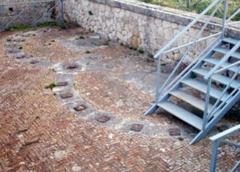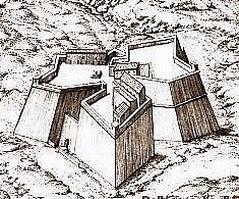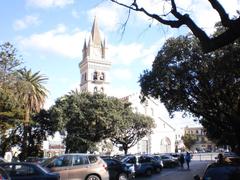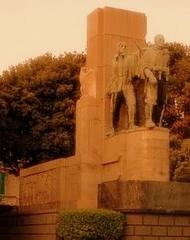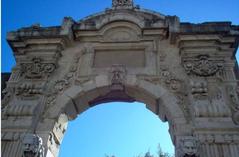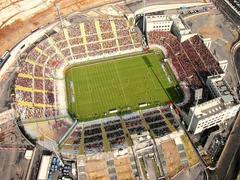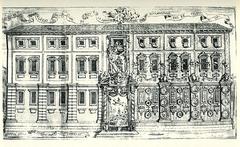San Placido Necropolis Visiting Hours, Tickets, and Travel Guide – Messina, Italy
Date: 14/06/2025
Introduction
The San Placido Necropolis in Messina, Sicily, is a remarkable site that encapsulates centuries of Mediterranean history, religious devotion, and artistic achievement. This guide provides detailed and organized information for visitors, including opening hours, tickets, accessibility, and practical travel tips. Whether you are passionate about archaeology, interested in religious history, or simply exploring Sicily’s cultural treasures, a visit to the San Placido Necropolis promises a rich and memorable experience.
For those seeking in-depth archaeological and historical context, consult resources like ISic3522, ISic3524, and the historical overview at granmirci.it. For up-to-date visiting hours and events, refer to the Messina tourism website.
Contents
- Introduction
- Location and How to Get There
- Visiting Hours & Ticketing
- Accessibility and Facilities
- Historical Background
- Museum Experience
- Cultural and Community Significance
- Events and Special Activities
- Visitor Experience and Site Features
- Nearby Attractions
- Frequently Asked Questions (FAQ)
- Tips for Visiting
- Conclusion
- References
Location and How to Get There
The San Placido Necropolis is situated in Messina, on the northeastern coast of Sicily, near the Church of San Placido and within a historic monastic complex. The main entrance is at Via San Giovanni di Malta n. 2, 98121 Messina, Italy, with GPS coordinates 38.078564, 15.487853 (Museo del Tesoro di San Placido). The necropolis can be easily reached by:
- Public Transport: Local buses and taxis operate from Messina city center, with clear signage to major attractions.
- By Car: Accessible via the SP35 road, with limited parking available near Ponte Schiavo and at the site itself.
- On Foot: The location is walkable from central Messina and other major sites.
Visiting Hours & Ticketing
-
Opening Hours:
Tuesday to Sunday, 9:00 AM – 6:00 PM
Closed on Mondays and major public holidays
(Messina Tourism Official Site) -
Admission Fees:
- Adults: €8
- Reduced (EU citizens aged 18–25): €5
- Children under 18: Free
- Guided tour supplement: €5
Tickets can be purchased at the entrance or online via the official tourism portal.
-
Guided Tours:
Available by advance booking; recommended for an in-depth exploration of the necropolis’s history and artifacts. -
Special Events:
Opening hours may vary during festivals or restoration periods—always confirm in advance via the official website.
Accessibility and Facilities
- Physical Access:
The main museum spaces and some chapels have ramps and paved paths, making them accessible to visitors with mobility challenges. However, some historic areas feature uneven flooring or steps. - Assistance:
Visitors needing special access should contact the museum ahead to arrange accommodations. - Facilities:
Restrooms and a museum shop are available on site. - Photography:
Allowed in most areas, but flash photography is prohibited to protect artworks. - Parking:
Limited parking is available on site. Public transport is recommended during peak periods.
Historical Background
Ancient and Early Christian Origins
The necropolis dates to the Roman Imperial period (1st–5th centuries CE), offering valuable insights into Messina’s funerary customs and the transition from pagan to Christian burial practices (ISic3522). Archaeological discoveries include tombs, inscriptions in Greek and Latin, and a rich array of artifacts that reflect the city’s multicultural fabric (ISic3524).
Monastic and Religious Heritage
The site is closely linked to Saint Placidus, a 6th-century Benedictine monk and martyr, whose cult became central in Messina after the rediscovery of his relics in 1588 (Gazzetta del Sud; granmirci.it). The necropolis and its adjoining monastery were centers of pilgrimage, spiritual activity, and artistic production throughout the Middle Ages and Renaissance (it.wikipedia.org).
Preservation and Restoration
Ongoing restoration has focused on the Renaissance cloisters, medieval chapels, and the conservation of funerary monuments. Modern interventions ensure the site remains accessible and vibrant while respecting its historical integrity.
Museum Experience: Museo del Tesoro di San Placido
Within the church complex, the Museo del Tesoro di San Placido presents a curated collection that contextualizes the necropolis’s significance:
- Silver artifacts (16th–19th centuries)
- Ancient silk vestments
- Paintings and sculptures
- Reliquary casket of Saint Placido (1616)
- Papal bull of Sixtus V (1588)
These treasures illuminate the religious, social, and artistic history of Messina and the Benedictine order (Museo del Tesoro di San Placido).
Cultural and Community Significance
The necropolis is not only an archaeological site but also a living symbol of Messina’s enduring faith and identity. Annual events such as the Festa di San Placido attract pilgrims and visitors, while the contemporary use of parts of the complex for educational and cultural activities fosters community engagement (granmirci.it).
Events and Special Activities
- Religious Festivals:
The annual feast of Saint Placidus in February and other liturgical celebrations feature processions, masses, and public displays of relics. - Cultural Events:
Concerts, art exhibitions, and wine tastings are held in the renovated cloisters, especially during grape harvest season. - Educational Activities:
The presence of the Istituto Tecnico Agrario “Pietro Cuppari” enriches the visitor experience with agricultural exhibits and tastings of local Sicilian wines.
Visitor Experience and Site Features
Architectural Highlights
- Renaissance Cloisters:
Elegant Ionic columns and arcaded walkways create tranquil spaces for reflection. - Byzantine “Cuba”:
A cubic domed building of possible Arab-Byzantine origin, adorned with Baroque stuccoes and sixteenth-century frescoes. - Tombs and Chapels:
Notable burials include that of mathematician Francesco Maurolico, with sculptural works by Rinaldo Bonanno.
Panoramic Views
The necropolis’s hilltop location offers sweeping views over the Strait of Messina and the Calabrian coast—ideal for photography and contemplation.
Nearby Attractions
- Cathedral of Messina:
Famed for its astronomical clock. - Regional Museum of Messina:
Houses many necropolis artifacts. - Sanctuary of the Madonna di Montalto and local markets enrich the cultural itinerary (Enjoy Sicilia Typical Products).
Frequently Asked Questions (FAQ)
Q: What are the San Placido Necropolis visiting hours?
A: Tuesday to Sunday, 9:00 AM – 6:00 PM. Closed Mondays and major holidays.
Q: Is there an admission fee?
A: Yes. Adults €8, reduced €5, children under 18 free. Guided tour supplement €5.
Q: Is the site wheelchair accessible?
A: Main areas are accessible, but some historic sections may present challenges. Contact ahead for assistance.
Q: Are guided tours available?
A: Yes, for an additional fee; advance booking is recommended.
Q: Can I take photographs inside?
A: Yes, but no flash. Observe signage and staff instructions.
Tips for Visiting
- Plan Ahead:
Check the official website for the latest information on hours, restoration works, and events. - Book Tours in Advance:
Guided tours enhance your understanding and are in high demand during peak seasons. - Dress Respectfully:
Modest attire is recommended, especially in chapel areas. - Visit Early or Late:
For quieter experiences and the best light for photography. - Combine Visits:
Explore nearby sites for a comprehensive understanding of Messina’s history.
Conclusion
The San Placido Necropolis is a unique site where the ancient, medieval, and modern worlds converge. Its blend of archaeological wonders, religious significance, and cultural vitality makes it a must-see for anyone visiting Messina or Sicily. With ongoing restoration and community engagement, the necropolis remains a vibrant testament to the city’s layered history and living heritage.
To plan your visit, consult the Messina tourism website and consider downloading travel apps for personalized guides and updates. Whether you are a history buff, a spiritual pilgrim, or a curious traveler, the San Placido Necropolis offers a profound and memorable journey into Sicily’s past and present.
References
- ISic3522, Zenodo
- ISic3524, Zenodo
- Vita e morte di S. Placido, Compatrono di Messina, Gazzetta del Sud
- San Placido and Benedictine Heritage, Granmirci.it
- Monastero di San Placido Calonerò, Wikipedia Italy
- Museo del Tesoro di San Placido, Live the World
- Messina Tourism Official Site
- Enjoy Sicilia Events
- Hikersbay Messina Travel Information
